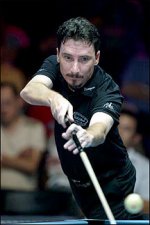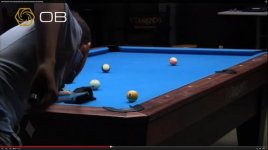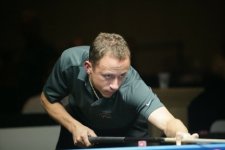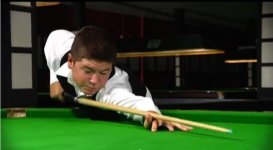I just had to let you know again how pleased I am about this information. I have been working with this for about a week now and it has help me more than you will ever know. I just now need to work on speed control because I do not have to shoot as hard as I did before. Here is a link that shows you just what is needed and how to do this stroke perfectly. https://www.youtube.com/watch?v=_kL9ena6j6M This was posted before by another AZ member so I am by no means taking credit for it. 29:37 of this video shows what you are talking about perfectly. Thanks again.There appear to be three different techniques for the wrist to assist the pocket billiards stroke. The first one is the wrists don't do much at all, the second is they cock up as you hit the cue ball and finish the stroke and the other is the wrists uncock down as the cue ball is struck and the follow through is completed.
The way I play is definitely with the wrists cocking down as I contact the cue ball. I have been committed to this technique the last couple of days and it's amazing the results. The thing about my technique is I can pre cock my wrists very precisely and that was how I consistently produce powerful stoke shots with such accuracy. This, ironically is what I've been struggling with the most. I seemed to have lost my "power source" that effortlessly produced pin point accuracy when striking the cue ball.
Many of you will not benefit from this information (because the way you use your wrists work fine for you), and others will benefit immensely when you're still searching to improve your stroke and accuracy.
I personally found a missing part to my "personal puzzle" and I'm surprised I didn't "real eyes" how important this technique was for me. Sometimes the simplest answers complete the most complex problems {for myself}.
For some reason my "reasonable" mind says "use outside english", however a "Touch of Inside" produces best results, and my mind says "don't use the wrists", however uncocking my wrists like I'm using a hammer is most effective, and my mind says "root against my opponent" when pulling for my opponent works best. The key to life seems to be making myself do {at times} what I least "naturally" want to do. As I get "more experienced" I see that unfolding in many areas.
The Moral of the story? "Reasonable" thoughts and techniques can often be the wrong thoughts and techniques to reach the highest levels. To separate yourself you must be "Unreasonable" at times. 'The Game is the Teacher'

You are using an out of date browser. It may not display this or other websites correctly.
You should upgrade or use an alternative browser.
You should upgrade or use an alternative browser.
WRISTS - The "hidden power catalyst" of a great stroke or "just along for the ride"?
- Thread starter CJ Wiley
- Start date
You can improve at this game every day, in every way
Thanks, I'm glad you're benefiting from the knowledge.
I have a student that's actually a carpenter and his game has improved dramatically ever since he learned this technique. He's now enjoying the game more and improving every week as a result of TOI, the Hammer Stroke and the 3 Part Pocket System. His pre shot routine is also getting better on a weekly basis.
You can improve at this game every day, in every way WITH the right information.
Aloha, the game is our teacher.......CJ
I just had to let you know again how pleased I am about this information. I have been working with this for about a week now and it has help me more than you will ever know. I just now need to work on speed control because I do not have to shoot as hard as I did before. Here is a link that shows you just what is needed and how to do this stroke perfectly. https://www.youtube.com/watch?v=_kL9ena6j6M This was posted before by another AZ member so I am by no means taking credit for it. 29:37 of this video shows what you are talking about perfectly. Thanks again.
Thanks, I'm glad you're benefiting from the knowledge.
I have a student that's actually a carpenter and his game has improved dramatically ever since he learned this technique. He's now enjoying the game more and improving every week as a result of TOI, the Hammer Stroke and the 3 Part Pocket System. His pre shot routine is also getting better on a weekly basis.
You can improve at this game every day, in every way WITH the right information.
Aloha, the game is our teacher.......CJ
Thanks, I'm glad you're benefiting from the knowledge.
I have a student that's actually a carpenter and his game has improved dramatically ever since he learned this technique. He's now enjoying the game more and improving every week as a result of TOI, the Hammer Stroke and the 3 Part Pocket System. His pre shot routine is also getting better on a weekly basis.
You can improve at this game every day, in every way WITH the right information.
Aloha, the game is our teacher.......CJ
The best thing I've learned from you,is pressing down firm with the bridge hand.I don't know the reason why it works,but I feel more like a pool player.
"press" forward slightly to engage the outside muscles back in the other direction
Yes, this is very important, the lest side supplies the structure for the stroke. If it moves the shot will most likely be effected, pressing your fingers of your bridge hand helps.
Also, there's momentum issue that should be addressed. When the bridge hand is lowered to the table it will want to continue in the same direction. I've found it very helpful to "press" forward slightly to engage the outside muscles back in the other direction....this will keep your bridge arm and hand more stable as well.
The best thing I've learned from you,is pressing down firm with the bridge hand.I don't know the reason why it works,but I feel more like a pool player.
Yes, this is very important, the lest side supplies the structure for the stroke. If it moves the shot will most likely be effected, pressing your fingers of your bridge hand helps.
Also, there's momentum issue that should be addressed. When the bridge hand is lowered to the table it will want to continue in the same direction. I've found it very helpful to "press" forward slightly to engage the outside muscles back in the other direction....this will keep your bridge arm and hand more stable as well.
Scott Lee had one, and I had a chance to try it out a few years ago. I think it is an excellent product.
Here's a couple videos on a couple new products in England that appears to have a lot of RD behind them. If you're not impressed or interested in the product just sit and listen to them talk about the various culprits for stroking flaws......the main two being the lateral movement of the arm (although not mentioned in the video, is caused by the shoulder) and the wrist.
https://www.youtube.com/watch?v=RRYrBnXG2dk
https://www.youtube.com/watch?v=f6RRZYLBRag
Kinda interesting, although the flexible one seems to dictate a snooker-style piston stroke, which I don't like.Here's a couple videos on a couple new products in England that appears to have a lot of RD behind them. If you're not impressed or interested in the product just sit and listen to them talk about the various culprits for stroking flaws......the main two being the lateral movement of the arm (although not mentioned in the video, is caused by the shoulder) and the wrist.
https://www.youtube.com/watch?v=RRYrBnXG2dk
https://www.youtube.com/watch?v=f6RRZYLBRag
It also seems to make this guy flinch - that can't be good...
View attachment 49677
Attachments
.....................
Last edited:
I don't like it for myself, or to teach beginners. It looks effective once mastered, but the extra difficulty doesn't seem to pay off with much advantage IMO.So you don't like the snooker style stroke, eh?
To each his own.
pj
chgo
it's basically like a "forward press" in golf - you're pressing towards the cue ball
This refers to the muscles on the outside of the bridge arm, facing up. The left arm is for structure, it's basically like a "forward press" in golf, however, you're pressing towards the cue ball.
I like the sound of this but have no idea what you're talking about. "Outside muscles"......what is this? Thanks.
DTL
This refers to the muscles on the outside of the bridge arm, facing up. The left arm is for structure, it's basically like a "forward press" in golf, however, you're pressing towards the cue ball.
Here's a couple videos on a couple new products in England that appears to have a lot of RD behind them. If you're not impressed or interested in the product just sit and listen to them talk about the various culprits for stroking flaws......the main two being the lateral movement of the arm (although not mentioned in the video, is caused by the shoulder) and the wrist.
https://www.youtube.com/watch?v=RRYrBnXG2dk
https://www.youtube.com/watch?v=f6RRZYLBRag
The kid in that video already has a great stroke. In order to make the cue bend laterally, he had to apply so much wrist movement that his shoulder was actually pulled out of line. Even the worst beginner gets past that kind of grotesque movement by the end of day one.
Too much wrist can surely ruin a stroke, but an "educated" forward flick incorporated with correct timing can add a lot to a stroke's finish (i.e. add directional stability and extra velocity) without have to use the larger (and more difficult to control) muscles of the arm to accomplish the same finish.
As far as that device goes, I don't care how much R&D went into it (really... a spring in the butt took a lot of R&D?), I think mechanical devices like that can only do harm. I've seen people use little devices on their kids violins to help them keep the bow stroke tracking straight. Never seen one of them make it even into a good community youth orchestra. Why? Because the feedback gained from the ears tells you if the bow is going straight or not. Good tone is not possible with a wavering bow stroke, so merely trying to work on a great tone does more to teach the bow to track straight than any artificial means can. The kids using the device never develop great tone because they are using the wrong feedback loop to attain stroke straightness.
Pool is different because it is a visual activity in the first place. Call me old fashioned, but I think there is a lot of value in using your vision to tell you if the cue is tracking straight or not. If you can't learn to easily see that shaft wobbling all over the place and use that visual to correct your stroke, maybe it's time to quit pool and take up the violin.
This refers to the muscles on the outside of the bridge arm, facing up. The left arm is for structure, it's basically like a "forward press" in golf, however, you're pressing towards the cue ball.
FWIW I apply the same "rooting" principle for my bridge as I do with my martial art stances. I visualize my hand relaxing into my fingers, which then relax into the table bed. The result is a firm, stable, but tension-free bridge. This has become mostly second nature at this point, but when I start shooting really poorly, the first place I look at is my bridge hand. Invariably, my hand has gotten tense, wobbly and "unrooted".
You shoot great, CJ, but I think the vast majority of players would be better served if they incorporated more relaxation into their fundamentals rather than deliberately adding unnecessary tension.
Just my dos centavos.
^ ^ ^ ^ ^ ^^ ^
Fairly good post.
I especially like the part about the wrist/hand vs the larger muscles & larger movement.
Golf has a training club called Medicus. It has a 'hinge' in the shaft. I think this may be the manufacturer's attempt to emulate that training device.
I tried a Medicus in a used sporting goods store. It showed me immediately that I had a slight flaw in my take away. That 3 to 5 minutes had a very good impact on all of my subsequent golf. I did not even buy the club as it had just fixed my flaw.
The thing about the Medicus is that it is feel based. If the swing is made properly the club shaft stays in line & one can actually hit a golf ball.
But...if it, the swing, is off, the shaft breaks down & one feels it immediately & can then try to make the necessary adjustment to keep it from breaking down.
I don't see how this spring cue can do that.
I think it is important to state that in order to use the wrist/hand/fingers correctly & to stay on line one must somehow find that 'channel' to which CJ often refers. If one is not connected to the cue just right the wrist action can send the tip off line by even just the slightest amount.
IMO It's a good idea to check one's wrist action to assure that it is on line. In baseball & golf one can make a visual check but that's not the case in pool.
Best 2 All,
Rick
Fairly good post.
I especially like the part about the wrist/hand vs the larger muscles & larger movement.
Golf has a training club called Medicus. It has a 'hinge' in the shaft. I think this may be the manufacturer's attempt to emulate that training device.
I tried a Medicus in a used sporting goods store. It showed me immediately that I had a slight flaw in my take away. That 3 to 5 minutes had a very good impact on all of my subsequent golf. I did not even buy the club as it had just fixed my flaw.
The thing about the Medicus is that it is feel based. If the swing is made properly the club shaft stays in line & one can actually hit a golf ball.
But...if it, the swing, is off, the shaft breaks down & one feels it immediately & can then try to make the necessary adjustment to keep it from breaking down.
I don't see how this spring cue can do that.
I think it is important to state that in order to use the wrist/hand/fingers correctly & to stay on line one must somehow find that 'channel' to which CJ often refers. If one is not connected to the cue just right the wrist action can send the tip off line by even just the slightest amount.
IMO It's a good idea to check one's wrist action to assure that it is on line. In baseball & golf one can make a visual check but that's not the case in pool.
Best 2 All,
Rick
Last edited:
"Relaxing" into the bridge has caused many players to misfire under pressure
We'll have to "agree to disagree" on this one.
The bridge needs to be firm and not have any movement, especially lateral (I do some movement, just not allowing the cue tip to move left or right, up or down is okay). "Relaxing" into the bridge has caused many players to misfire, especially under pressure. When I'm playing seriously I'll feel like I'm digging my fingers into the slate. This is not a good place to relax in your game, it will lead to some other bad habits if the player's not careful. imho
FWIW I apply the same "rooting" principle for my bridge as I do with my martial art stances. I visualize my hand relaxing into my fingers, which then relax into the table bed. The result is a firm, stable, but tension-free bridge. This has become mostly second nature at this point, but when I start shooting really poorly, the first place I look at is my bridge hand. Invariably, my hand has gotten tense, wobbly and "unrooted".
You shoot great, CJ, but I think the vast majority of players would be better served if they incorporated more relaxation into their fundamentals rather than deliberately adding unnecessary tension.
Just my dos centavos.
We'll have to "agree to disagree" on this one.
The bridge needs to be firm and not have any movement, especially lateral (I do some movement, just not allowing the cue tip to move left or right, up or down is okay). "Relaxing" into the bridge has caused many players to misfire, especially under pressure. When I'm playing seriously I'll feel like I'm digging my fingers into the slate. This is not a good place to relax in your game, it will lead to some other bad habits if the player's not careful. imho



